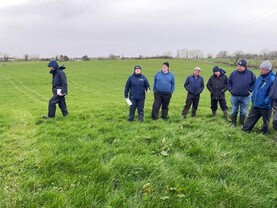Feed supply
There are very few sheep systems where grass supplies allocated for carrying ewes over the winter have not been depleted. As such, it is inevitable that supplementary feed is required to meet ewe nutritional requirements.
Reports indicate ewe condition varies significantly at farm level, and this will dictate the feeding programme.
Where ewes fall within a condition score of 2.5 to 3, then there is no room for any complacency, and such ewes should be grouped together and receive preferential treatment.
Ewes falling within a condition score of 3.5 to 4 plus can be fed to maintenance or slightly below, but take care to limit any weight loss in mid-pregnancy to a maximum of 5% of bodyweight.
Minimising weight loss is key here, with body reserves much more valuable in late pregnancy and early lactation. A typical diet of poor-quality grass or silage of 65 DMD to 68 DMD will witness ewes gradually lose condition, and this should be monitored on an ongoing basis.
The nutritional demands of the majority of ewes in adequate condition in mid-pregnancy will be satisfied by offering access to ad lib silage of 67DMD to 70DMD.
Provided silage is of good-quality and palatable, with a crude protein content of 11% to 12% plus, then no other supplementation will be required with the exception of minerals/vitamins where applicable.
Ewes will typically eat upwards of 1kg silage dry matter or 5kg silage fresh weight at 20% dry matter or 3.5kg to 4kg at 25% to 30% dry matter. Precision chop silage and higher quality silage will promote higher intake over single chop silage.
Issues occur with poor-quality silage as, in addition to lower feed quality, intake will also be depressed. For example, where silage quality is below 60DMD and is wet, which is a big possibility this year with delayed harvesting, then ewes will only be capable of consuming 0.6kg to 0.7kg DM.
Combined with the low feeding quality, ewes will only be receiving 50% to 60% of their daily nutritional requirements and weight loss will be rapid. In such scenarios, ewes will need access to additional supplementation or alternative higher quality forage.
Winter shearing
The improvement in weather has finally provided more suitable conditions to get sheep housed dry. Time is pushing on for farmers considering winter shearing of ewes, with the cold snap further delaying activity.
Shearing should only be carried out where there is at least eight weeks wool regrowth and ewes are being turned outdoors from March onwards.
A shorter period of wool regrowth or earlier turnout dates increases the risk of ewes being exposed to sustained lower temperatures and succumbing to health issues during adverse weather.
The benefits of winter shearing are well documented, with Teagasc research showing that winter shearing can increase lamb birth weight by 0.6kg without increasing lambing difficulty and improving weaning weights by up to 1.9kg.
Management benefits are also numerous, allowing 15% more ewes to be housed in a given space (provided feed space is adequate), easier monitoring of body condition and scope for better hygiene.
Where shearing is not being carried out, then significant benefits can be obtained from crutching ewes. This involves clipping the wool from the belly and tail region, and is aimed at keeping ewes cleaner, improving overall hygiene and aiding lambs to suckle easier.






 This is a subscriber-only article
This is a subscriber-only article










SHARING OPTIONS: